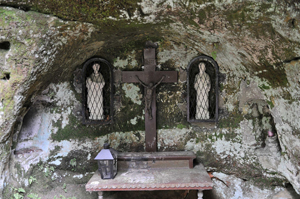
In the interior, 2 statues were installed in memory of Schetzelo (right) and Archadus (left). Their solemn blessing by bishop J. Hengen happened in August 1970.
The beatified Schetzelo, also called Schetzel, was a hermit, who lived in the Grünewald in the 12th century, where he spent a very isolated life, probably from 1124 until his death on the 11th of August 1138 or 1139 (the exact year of his death is uncertain).
The beatified Schetzelo was probably a Cistercian monk, who came from the Orval monastery. He was a hermit, a man who deliberately chose to spend his life in isolation and Spartan repentance, in order to be closer to the Lord.
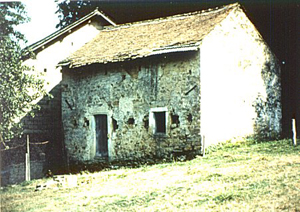
Old farm house in Hostert, where the hermit was offered bread, according to the legend.
He was a precious adviser to many persons and slept in a grotto on the floor. He took the forest plants for nourishing himself and drank the water of the White Ernz, called “Schetzelbour”, which sources at about 200m from the grotto. Sometimes in the last 4 years of his life, during the hard wintertime, Schetzelo left his cave to spend the night in the yard of a neighbour farm, where he slept on straw and had a piece of bread offered. Before the dawn however he returned to his cave to regain his solitude.
The only written document that proves the existence of Schetzelo, is the report of the Archadus of Clairveaux, telling that he met the hermit. His report was written down by Brother Herbertus. All the other stories seem to be legends.
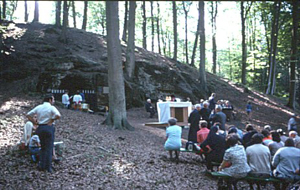
Every year at the second Sunday in August, there is a commemoration service for the hermit called “Schetzelfeir” in the forest, which is blessed at the same occasion.
Schetzelo died in the same way as he lived: in solitude. At his funeral the monks and the locals came in masses to bury him at the entrance of his grotto, where they erected a wooden chapel. In 1150, his corpse was transferred to the Benedict Abbey of Altmünster where he was buried in a silver coffin just in front of the high altar of the abbey church. His relics were highly venerated until the abbey’s destruction in 1543. Apparently many miracles happened at his tomb and until today his last gravesite has never been located.
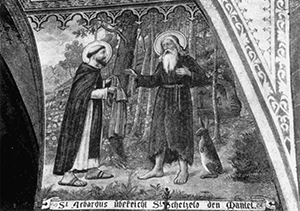 Fresco in the church of Hostert, unfortunately plastered by renovating the church in 1972/73. Archardus offers a coat or a monk frock to Schetzelo, the hermit who probably was a monk and in contact with the monastery.
Fresco in the church of Hostert, unfortunately plastered by renovating the church in 1972/73. Archardus offers a coat or a monk frock to Schetzelo, the hermit who probably was a monk and in contact with the monastery.
The Schetzelo grotto
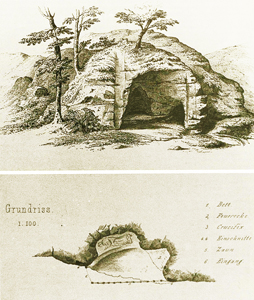
Exterior view and horizontal scheme of the Schetzelo grotto. Print of the national architect Charles Arendt (1860).
The grotto, carved into the Luxembourg Sandstone layer, where the beatified hermit Schetzelo lived, is called Schetzelo grotto or “Eremitage” and had developed naturally but had been artificially enlarged later on. With approximately 3m width, 2.50m depth and 2.50 m height, the grotto protected the hermit against the elements. The grotto, which was entombed over many years, had been reopened in the 19th century by the priest J. Klein of Weimerskirch.
